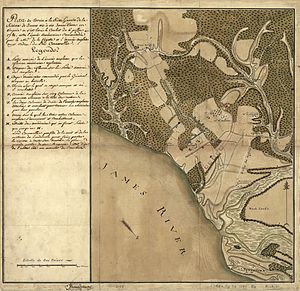| Battle of Green Spring | |||||||
|---|---|---|---|---|---|---|---|
| Part of the American Revolutionary War | |||||||
 A French map depicting the battle | |||||||
| |||||||
| Belligerents | |||||||
|
|
| ||||||
| Commanders and leaders | |||||||
|
|
| ||||||
| Strength | |||||||
| 800-900[1][2] | about 7,000[3] | ||||||
| Casualties and losses | |||||||
|
28 killed 122 wounded[1] | 75 killed and wounded[1] | ||||||


The Battle of Green Spring took place near Green Spring Plantation in James City County, Virginia during the American Revolutionary War. On July 6, 1781 United States Brigadier General "Mad" Anthony Wayne, leading the advance forces of the Marquis de Lafayette, was ambushed near the plantation by the British army of Earl Charles Cornwallis in the last major land battle of the Virginia campaign prior to the Siege of Yorktown.
Following a month of marching and countermarching in central Virginia by Cornwallis and Lafayette, Cornwallis in late June moved to Williamsburg, where he received orders to move to Portsmouth and send some of his army to New York City. Lafayette followed Cornwallis fairly closely, emboldened by the arrival of reinforcements to consider making attacks on the British force. On July 4, Cornwallis departed Williamsburg for Jamestown, planning to cross the James River en route to Portsmouth. Lafayette believed he could stage an attack on Cornwallis's rear guard during the crossing.
Cornwallis anticipated Lafayette's idea, and laid an elaborate trap. General Wayne's forces were very nearly caught in the trap, and only a bold bayonet charge against the numerically superior British enabled his forces to retreat. Cornwallis did not follow the victory with pursuit, instead following his plan to cross the river. The action reinforced the perception among contemporaries that justified the moniker "Mad" to describe Wayne, although opinion on the merits of his actions was divided. The battlefield has been partially preserved, and reenactments are sometimes staged.
- ^ a b c Cite error: The named reference
C311was invoked but never defined (see the help page). - ^ Cite error: The named reference
L466was invoked but never defined (see the help page). - ^ Clary, p. 310 cites this number as Cornwallis' approximate total strength. The forces actually engaged would have been lessened at a minimum by the absence of Simcoe's Rangers, protecting the baggage on the far side of the river (Wickwire, p. 343).
© MMXXIII Rich X Search. We shall prevail. All rights reserved. Rich X Search
